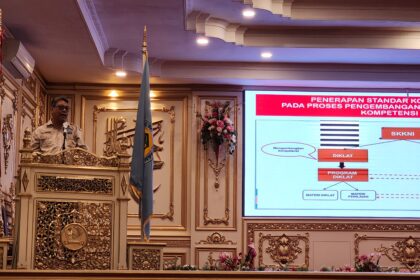[ad_1]
JAKARTA – Soon to be joined by vessels from other countries, the Indonesian Navy is in a race against time to find a 40-year-old German-built submarine that went missing 96 kilometers off the north coast of Bali on Wednesday with 53 crewmen aboard.
Sonar operators said they lost contact with the KRI Nanggala-402 soon after it was given permission to dive at the start of what was described as a live torpedo drill. The Type-209 submarine can remain submerged for two to three days.
A search plane reported spotting a broad oil slick and some unidentified debris where the 1,395-ton Nanggala went down in the Java Sea at the approaches to the Lombok Strait, separating Bali and neighboring Lombok island.
The average depth of the Java Sea is a relatively shallow 45 meters, but sailors with experience of the waters around Bali say there are canyons off the island’s north coast that are as deep as 600-700 meters, enough to crush a submarine.
Speculation for the cause of the accident has ranged from an electrical malfunction to an ordnance explosion at depth, similar to that which sank the Russian nuclear-powered submarine Kurski in the Barents Sea in August 2000.
With Defense Minister Prabowo Subianto flying to the submarine’s base at Banyuwangi, southeast of the port city of Surabaya, the navy has reportedly already contacted relatives of the missing crewmen to tell them not to hold out too much hope for their survival.
Indonesia sent a distress call to the International Submarine Escape and Rescue Liaison Office (ISMERLO) five hours after it lost contact with the Nanggala and Singapore quickly dispatched its 4,200-ton submarine rescue vessel MV Swift Rescue to the scene.
The only vessel of its kind in the Asian region, it is equipped with a deep submergence rescue vehicle which in early 2015 allowed it to find the wreckage of Indonesia Air Asia Flight 8501 at the bottom of the Java Sea. All 162 people on board died in that crash.
The Australian Navy has also offered to help, but it is too far away to send its Henderson, West Australia-based LR5 rescue vehicle, which can evacuate 16 survivors at a time from a distressed submarine at depths of up to 650 meters.
A similar Royal Navy deep-water submersible was used briefly in the effort to rescue the crew of the Kursk, but it did not get to the scene in time and all 118 crewmen died under circumstances that caused considerable soul-searching across Russia.
The last time the global rescue community was mobilized was in 2017 when the Argentinean Navy’s German-built ARA San Juan disappeared during a routine patrol in the South Atlantic, apparently after a power failure.
The wreck of the 2,100-ton TR-1700 was found the following year spread over 8,000 square meters of seabed at a depth of 900 meters, 400 meters more than a Type-209 submarine could survive in.
The small number of countries with a rescue capability usually have only 72 hours to react, transport and mobilize, otherwise they will exceed the window known to submariners as “the time of first rescue.â€
If a submarine sinks and can’t surface because it has taken on too much water, crewmen are trained to escape individually through an airlock-type escape tower, but beyond a depth of 180 meters, a submersible is necessary.
At the time of its disappearance, the Nanggala was engaged in an exercise with the hydrographic vessel KRI Rigel and two corvettes that was to have been observed later that day by armed forces commander Air Chief Marshal Hadi Tjahjanto.
Sixty-eight of the Type-209 diesel-electric attack submarines remain in service with 14 navies around the world, including South Korea, India, Turkey, Greece Egypt, South Africa and seven South American countries.
Indonesia has five 209s in its inventory, all of them the 1300 and 1400 variants armed with eight bow torpedo tubes and storage for 14 torpedoes, which can be launched from either the surface or underwater.
The missing submarine was delivered in 1981 and underwent a refit between 2010 and 2012 in South Korea’s Daewoo Shipbuilding and Engineering and at PT Pal’s Surabaya shipyard between 2016 and 2019.
Three more submarines were ordered in 2019, one to be assembled jointly under a transfer of technology agreement and the remaining two to be built independently in Surabaya as part of Indonesia’s military modernization program focused mainly on the navy and air force.
Indonesia’s main submarine base was established at Palu, Central Sulawesi, in 2013, but the role of its underwater force took on more importance three years later following an incident with a Chinese Coast Guard vessel near the Natuna Islands.
Last year, the navy began construction of a submarine replenishment station on Natuna Besar, the main island in the country’s northernmost archipelago, where the military is also extending the runway to accommodate both C-130 cargo planes and fighter aircraft.
The island also serves as the base for four navy corvettes brought in to reinforce lightly armed fisheries protection vessels that were proving to be an insufficient deterrent in protecting the nation’s 200-nautical-mile Economic Exclusion Zone (EEZ).
Navy analysts say the increasing attention Indonesia is paying to its maritime surveillance and security in the southern reaches of the South China Sea has apparently not gone unnoticed in Beijing.
Over the past year, China’s main regional fishing fleet appears to have moved further out into the western Pacific, making increasing use of technology to chase the biomass around Palau and the Marshall Islands before it reaches Indonesian waters.
[ad_2]
Source link










